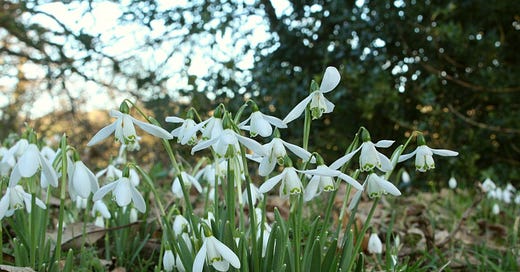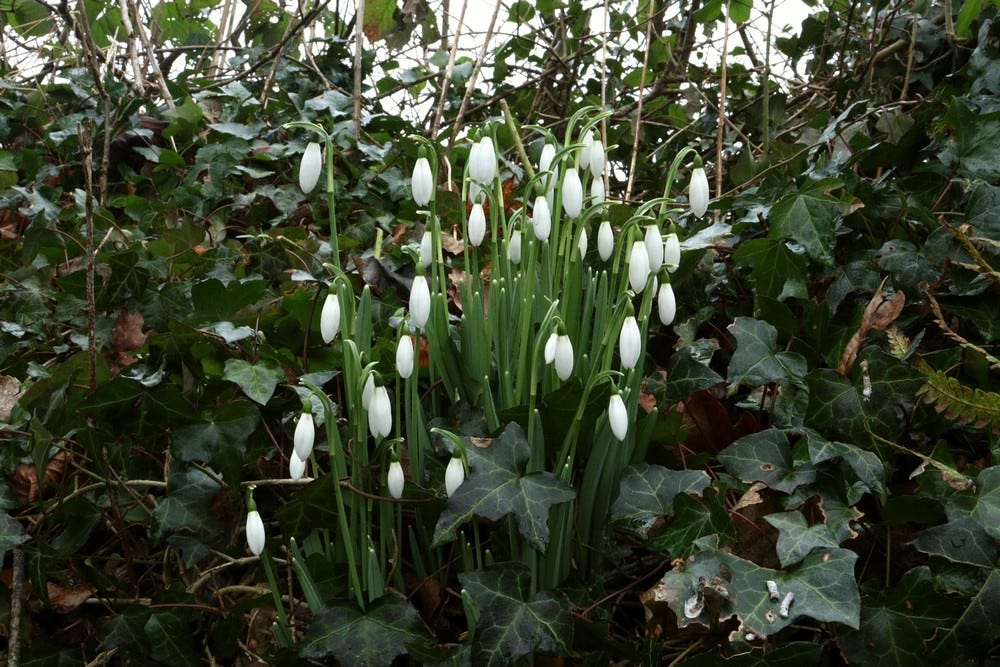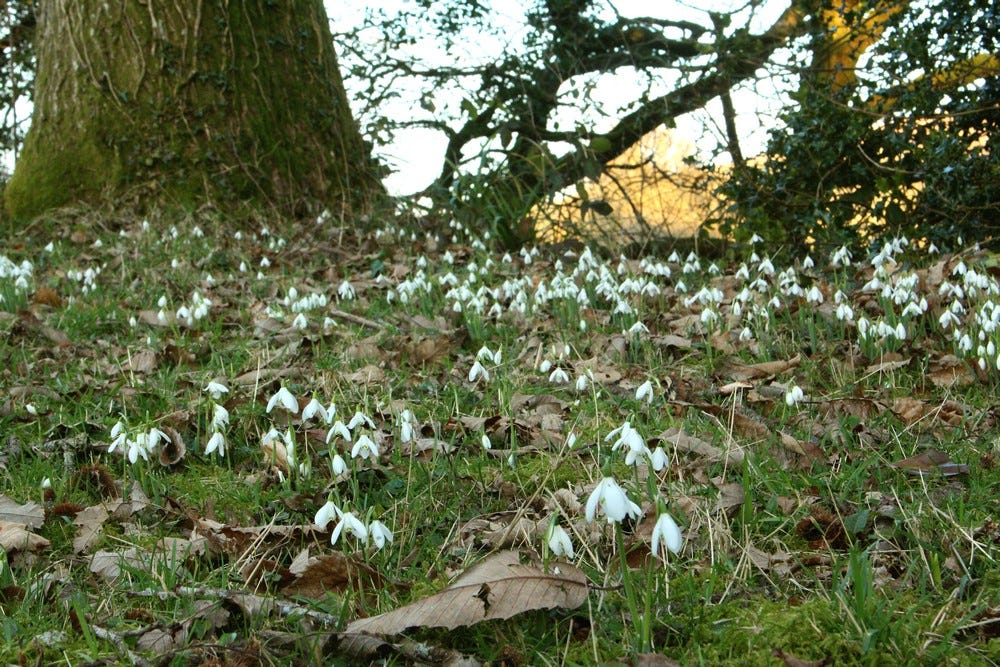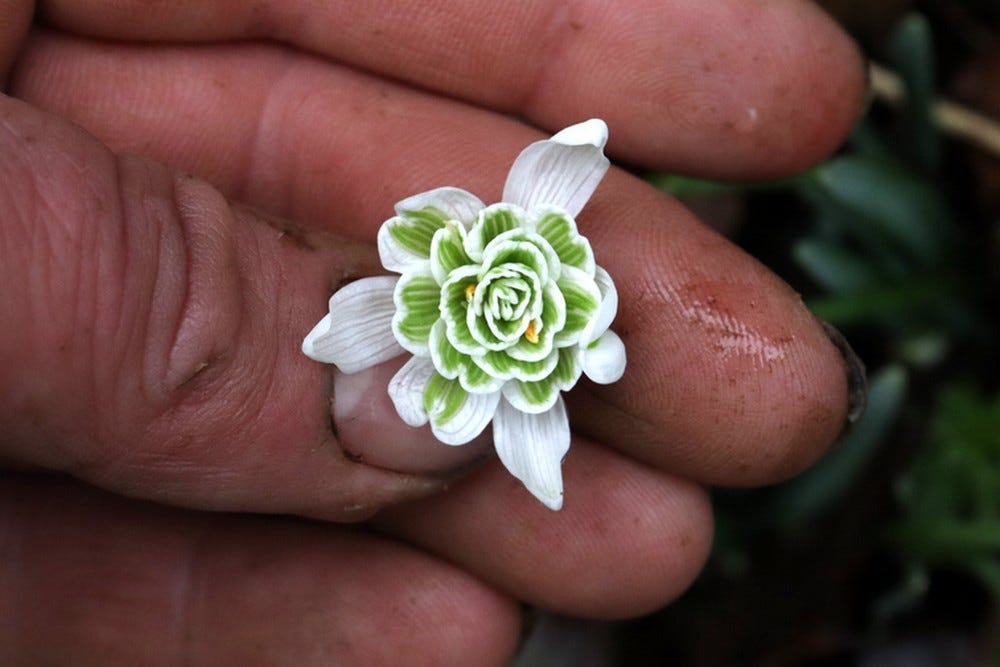I can't imagine winter without the snowdrop. The days are gently lengthening but not yet to the point where I'm thinking too hard about spring. Gardens are ticking away almost on standby mode; there are things happening but unless you have a winter garden there's not much going on apart from routine maintenance and a few winter shrubs flowering.
At this most unappealing of times the humble snowdrop, Galanthus nivalis, makes its presence known. There are many snowdrops available now, arguably too many and flowering from the autumn to late winter, but it's the most common of them all that I want to celebrate.
See, all snowdrops are incredibly beautiful. There are some with more unusual flowers that challenge this assertion, but they still manage to be sufficiently charming in their weird way. Collectors pursue subtle differences between selections yet the plain and common Galanthus nivalis remains an absolutely first rate plant.
So widespread and revered is the humble snowdrop that it's remarkable to think it's not actually strictly speaking a native British plant. It was introduced from continental Europe centuries ago, likely by the Romans, and has since become such a cultural icon that nobody of consequence really cares if it's native or naturalised.
“...it is a strange fact that the [snowdrop] is not mentioned by the greatest of our flower-loving poets, Chaucer and Shakespeare.”
From Gardens Of Delight by Eleanour Sinclair Rohde.
It's easy to see why the snowdrop has captured the imagination of so many people through the centuries; until comparatively recently there was very little of note to brighten the darkness of winter, and the snowdrop's flowers are so cleanly white and delicate that they seem to have a gently mystical charm. If cold and sleeping earth bears such gracious beauties then people are going to want that plant near to their homes. The snowdrop's flowering almost stands as an act of defiance against the bleak, cold winter.
“Theirs is a workmanship beyond all praise, as the corolla hangs by its slender and diminutive stalk. It is cupped by a marvellous calyx that one of Oberon's court artists painted a fairy green. What hardihood and valour, united to such delicacy- like the storm petrel's among the moving hills and vales of mid-ocean wastes.”
From World Without End by H.J. Massingham.
Other species have been introduced and there's a whole culture around collecting different snowdrops. It would be hypocritical of me to lambast people who like to collect things (you should see my library...), yet I can't muster enthusiasm for certain elements of the snowdrop collecting culture. The humble snowdrop has become a victim of gardening fashion, and consequently suffers from inflated pricing and quite frankly a sometimes unpleasant subculture within collecting circles. To my mind a plant of this beauty should be quietly treasured, gently revered and reverently adored; some use the size of their collections to inflate their egos, and prices for some snowdrops are ridiculous. I'd like to see the bubble burst and for the trendy gardeners to lose interest in snowdrops altogether; it would be nice to see the genus returned to those collectors who adore their plants with the gentle love they deserve.
Galanthus nivalis is fairly easy to grow and, thankfully is usually fairly inexpensive to buy so you can afford to plant enough to make a fine display. It prefers a soil that has uniform moisture through the year, so not too dry or too wet. It's common practice, and unfortunately has become gardeners' gospel, to divide snowdrops when they're actively in growth or 'in the green'. This is a myth; no plant actually wants to be divided while it's actively in growth. Snowdrops can be divided in active growth but that doesn't mean they actually like it. The best time to divide snowdrops is when they're dormant in summer, keeping them cool and slightly damp if you can't plant them straight away. However an old nursery custom of digging and sending snowdrops in active growth had become gardeners’ lore so it’s hard to get hold of good garden bulbs of Galanthus nivalis during their natural dormancy. Home gardeners are stuck buying them ‘in the green’, despite commercial suppliers successfully shipping fresh bulbs to nurseries during summer for potting up or planting out…
The holy grail with Galanthus nivalis is to have them seed and make great drifts of white. Where plants of one clone or population are grown you tend not to see much seeding and plants tend to stay in their clumps. However it’s worth getting snowdrops from a few different sources (and you don’t have to do this all in one go, you can add to them over the years) in the hope of getting enough genetic diversity to set copious amounts of seed. However conditions will need to be right for the best success.








I’m shouting hurrah from the sidelines! I love the appearance of common or garden snowdrops. We have big drifts which came as smaller clumps in our garden. It doesn’t matter how much abuse they get - accidental digging up by us when planting or intentional interference from voles and mice, they always battle through the rough old soil to make a starry appearance in the winter dark soil. They are such doers I’d not be without them.